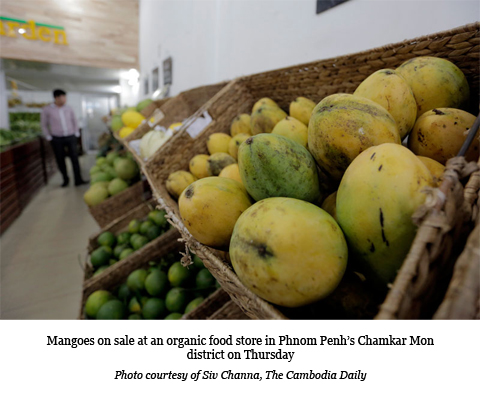by Holly Robertson and Neou Vannarin, The Cambodian Daily
International experts regularly touch down in Cambodia, usually to host seminars and workshops or impart knowledge to locals.
But Australian researchers have just wrapped up a field visit of a different kind to Battambang, Kompong Speu and Kandal provinces, where they spent nearly two weeks studying techniques used by Cambodian mango farmers.

The group of researchers, from several different states in Australia, are keen to discover how Cambodian farmers are able to produce two crops of mangoes each year—the first from March to May, and a second crop between August and February.
The project’s leader, Mark Hickey, from the New South Wales Department of Primary Industries, said in an email that the potential benefits to Australia were twofold: “An improved understanding of exotic pests and diseases which we don’t currently have in Australia [and] how the Cambodian farmers manage their crops to get two crops per year, ie what are the mechanisms in the tree that allow this.”
Mr. Hickey said that figuring out the secret behind “double-cropping,” and therefore encouraging mango trees to flower out of season, could allow Australian farmers to increase their earnings by staggering the availability of the fruit to consumers. It would also allow producers to make better use of packing houses, which lie dormant for much of the year.
“We hope that by learning how out of season flowering is achieved here it will help to better synchronize flowering of mango crops in Australia, which helps Australian farmers achieve a more even supply of fruit into markets, and therefore better returns for a longer period of time,” he wrote.
“In other words, avoid having a glut of fruit in the market when everyone harvests in the same window.”
Richard Markham, horticulture research program manager at the Australian Center for International Agricultural Research, which is funding the four-year project, said that staggering mango’s availability was important because of the delicacy of the fruit.
“When mangoes are left to their own devices, the fruiting season can be rather short and, because mangoes essentially cannot be stored, they are only in the shops for a few weeks,” Mr. Markham said in an email.
Hean Vanhorn, deputy director-general of the Agriculture Ministry’s agriculture department, said that the answer to the mango puzzle was simple: Local farmers are using additional “fertilizers and hormones” to gain two harvests a year.
“It does not affect the health of the mangoes if the farmers use it correctly,” he said.
However, Chay Van, president of the Kompong Speu Mangoes Association, said that only a small number of farmers in the province engage in double-cropping, as Cambodia lacks the infrastructure and demand to make it worthwhile.
“Only 30 percent of our mango farms produce the second season crop. We don’t have the market, and the production price is very high, so most of the farmers do not do it,” he said.
Mr. Van said that in light of these factors, he welcomed another aim of the Australian project—supporting Cambodian farmers to bring the quality of their product up to international standards in order to take advantage of overseas markets.
“We really need the technical support from any international partner to improve our mango production for exportation,” he said.
According to the agriculture department’s Mr. Vanhorn, there are no official statistics available on mango exports, because the fruit is often sent via informal routes to Thailand and Vietnam. The prevalence of pests such as fruit flies, along with low sanitation standards, have long acted as barriers to export, he added.
The first “authorized” mango exports began only earlier this year, after agriculture tycoon Mong Reththy built a $2-million processing plant in Preah Sihanouk province. Mr. Reththy, who has 500 hectares of mango trees in Kompong Speu and Preah Sihanouk provinces, sent 1,200 tons of the fruit to China and plans to target Singapore next year.
“In international markets, they require a lot,” Mr. Reththy said. “The important thing is quality, sanitation and killing the diseases. And [buyers] come to inspect the mango trees before accepting exportation deals.”
But even the seasoned businessman, who has taken the lead by setting up a plant that meets international standards, welcomed the prospect of outside help for the industry.
“It’s good if [the Australians] can give technical assistance, because if we receive funding without technical assistance, we will not profit,” he said.
Source: The Cambodia Daily
